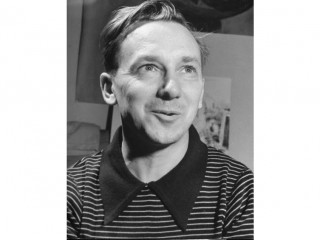
Candido Portinari biography
Date of birth : 1903-12-29
Date of death : 1962-02-06
Birthplace : Brodowski, São Paulo, Brazil
Nationality : Brazilian
Category : Arts and Entertainment
Last modified : 2011-01-22
Credited as : Artist painter, Modern Art,
The Brazilian painter Candido Portinari is best known for his murals, which fuse nativist and expressionist elements in a powerful and individual style.
Candido Portinari was born of Italian immigrant parents in the town of Brodosque in the coffee-rich state of São Paulo. No formal education was available to the boy beyond the first years of grade school. He attributed his interest in art to the fact that at the age of 8 he began helping a house painter. He went to Rio de Janeiro when he was 15 and worked as an artists' apprentice. He was always to approach his work in a disciplined and methodical way, regarding art as a handicraft or skill that could be consciously perfected.
Portinari won admission to the National Fine Arts School and in 1928 received the coveted annual travel fellowship to Europe. The experience shook him loose from the academic style he had been taught and brought him into the so-called Brazilian modernist artistic movement.
The first canvases Portinari executed are dominated by the dark reddish brown of the soil of his native region. Café (1935), depicting coffee pickers at work, suggests his somewhat impreseonistic early approach in which individuals play a very small role. Soon he was working in a geometric semiabstractionist style, for example, the Stevedores. His attention then turned to the depiction of antinaturalistic figures in massive, statuesque proportions. Finally, he began to combine groups and individuals in a way that lends his work a spatial ambiguity or tension between foreground figures and distant groups.
In 1937 Portinari received a commission to fresco the main halls of the Ministry of Education in Rio de Janeiro. His four murals (1941) for the Hispanic Foundation in the Library of Congress, Washington, D.C., monumental and vividly colored, depict the experiences of Hispanic Americans in dominating the land and resolving intercultural conflicts. Especially striking are the frenzied pattern and grasping gestures that depict mining activity. For the church of St. Francisco at Pampulha near Belo Horizonte, he executed murals and mosaics (1942-1943) and for the United Nations Building, New York City, the murals War and Peace.
From the 1940s until his death in Rio de Janeiro, Portinari kept up an active pace, doing murals, portraits, lithographs, book illustrations, and drawings. In the Crying Woman, one of his late paintings, he uses somber and muted colors to convey deep emotion; the facial features are barely suggested, and the hands and forearms are greatly exaggerated, creating a powerful effect.
Josias Leao, Portinari: His Life and Art (1940), includes some biographical material and has good color plates. See also the catalog by the Museum of Modern Art, Portinari of Brazil (1940).
















